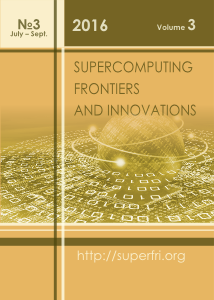Easy Access to HPC Resources through the Application GUI
Abstract
The computing environment at the King Abdullah University of Science and Technology (KAUST) is growing in size and complexity. KAUST hosts the tenth fastest supercomputer in the world (Shaheen II) and several HPC clusters. Researchers can be inhibited by the complexity, as they need to learn new languages and execute many tasks in order to access the HPC clusters and the supercomputer. In order to simplify the access, we have developed an interface between the applications and the clusters and supercomputer that automates the transfer of input data and job submission and also the retrieval of results to the researcher’s local workstation. The innovation is that the user now submits his jobs from within the application GUI on his workstation, and does not have to directly log into the clusters or supercomputer anymore. This article details the solution and its benefits to the researchers.References
1. Jim Almond and Dave Snelling. UNICORE: uniform access to supercomputing as an element of electronic commerce. Future Generation Computer Systems, 15(5):539-548, 1999. http://0-www.sciencedirect.com.libsys.kaust.edu.sa/science/article/pii/S0167739X99000072.
2. D. Auble, B. Christiansen, M. Jette, A. Sanchez, and T. Wickberg. Slurm workload manager. http://slurm.schedmd.com/slurm.html.
3. Martijn de Vries. Bright Cluster Manager for HPC. http://www.brightcomputing.com/product-offerings/bright-cluster-manager-for-hpc.
4. Ian Foster. Globus Toolkit Version 4: Software for Service-Oriented Systems. Journal of Computer Science and Technology, 21(4):513-520, 2006. http://link.springer.com/article/10.1007/s11390-006-0513-y.
5. Roger Henri, Pierre Lagier, and Didier Plaindoux. FSE grid middleware: Collaborative grid environment for distributed computing. Fujitsu Scientific and Technical Journal, 40(2):269-281, 2004. http://www.fujitsu.com/global/documents/about/resources/publications/fstj/archives/vol40-2/paper11.pdf.
6. Yuliya V. Karpievitch and Jonas S. Almeida. mGrid: A load-balanced distributed computing environment for the remote execution of the userdefined MATLAB code. BMC Bioinformatics, 7(1):139-139, 2006. http://bmcbioinformatics.biomedcentral.com
/articles/10.1186/1471-2105-7-139.
7. Fumikazu Konishi and Akihiko Konagaya. The Architectural Design of High-Throughput BLAST Services on OBIGrid. In Akihiko Konagaya and Kenji Satou, editors, Grid
Computing in Life Science: First International Workshop on Life Science Grid, LS-GRID 2004, Kanazawa, Japan, May 31-June 1, 2004, Revised Selected and Invited Papers, pages 32-42, Berlin, Heidelberg, 2005. Springer Berlin Heidelberg.
http://www.springer.com/us/book/9783540252085.
8. G. Kresse and J. Furthmüller. Efficient iterative schemes for ab initio total-energy calculations using a plane-wave basis set. PHYSICAL REVIEW B, 54(16):11169-11186, 1996.
9. Alexandre Morel. HPCSpot for HPC on demand. http://www.oxalya.com/?p=2173.
10. Harshadkumar B. Prajapati and Vipul A. Shah. Experimental study of remote job submission and execution on LRM through grid computing mechanisms. In IEEE, editor, Fourth International Conference on Advanced Computing & Communication Technologies, 2014.
11. X. Rozanska, P. Ungerer, B. Leblanc, P. Saxe, and E. Wimmer. Automatic and systematic atomistic simulations in the MedeA (r) software environment:
Application to EU-REACH. OIL & GAS SCIENCE AND TECHNOLOGY-REVUE IFP ENERGIES NOUVELLES, 70(3):405-417, 2015;2014;.
http://ogst.ifpenergiesnouvelles.fr/articles/ogst/abs/2015/03/ogst140090/ogst140090.html.
12. Maged F. Serag. Accelerating Development of a New Single-Molecule Localization and Tracking Technique. MathWorks Newsletter, 2016.
http://www.mathworks.com/company/newsletters/articles/accelerating-developmentof-a-new-single-molecule-localization-and-tracking-technique.html.
13. Wade Sisson. eQUEUE Job Submission Tool. https://www.youtube.com/watch?v=0IcTq4BMYwQ.
14. E. Strohmaier, J. Dongarra, H. Simon, and M. Meuer. Top 10 sites for June 2016. https://www.top500.org/lists/2016/06/.
15. G. te Velde, F. M. Bickelhaupt, E. J. Baerends, C. Fonseca Guerra, S. J. A van Gisbergen, J. G. Snijders, and T. Ziegler. Chemistry with ADF. Journal of Computational Chemistry, 22(9):931-967, 2001.
2. D. Auble, B. Christiansen, M. Jette, A. Sanchez, and T. Wickberg. Slurm workload manager. http://slurm.schedmd.com/slurm.html.
3. Martijn de Vries. Bright Cluster Manager for HPC. http://www.brightcomputing.com/product-offerings/bright-cluster-manager-for-hpc.
4. Ian Foster. Globus Toolkit Version 4: Software for Service-Oriented Systems. Journal of Computer Science and Technology, 21(4):513-520, 2006. http://link.springer.com/article/10.1007/s11390-006-0513-y.
5. Roger Henri, Pierre Lagier, and Didier Plaindoux. FSE grid middleware: Collaborative grid environment for distributed computing. Fujitsu Scientific and Technical Journal, 40(2):269-281, 2004. http://www.fujitsu.com/global/documents/about/resources/publications/fstj/archives/vol40-2/paper11.pdf.
6. Yuliya V. Karpievitch and Jonas S. Almeida. mGrid: A load-balanced distributed computing environment for the remote execution of the userdefined MATLAB code. BMC Bioinformatics, 7(1):139-139, 2006. http://bmcbioinformatics.biomedcentral.com
/articles/10.1186/1471-2105-7-139.
7. Fumikazu Konishi and Akihiko Konagaya. The Architectural Design of High-Throughput BLAST Services on OBIGrid. In Akihiko Konagaya and Kenji Satou, editors, Grid
Computing in Life Science: First International Workshop on Life Science Grid, LS-GRID 2004, Kanazawa, Japan, May 31-June 1, 2004, Revised Selected and Invited Papers, pages 32-42, Berlin, Heidelberg, 2005. Springer Berlin Heidelberg.
http://www.springer.com/us/book/9783540252085.
8. G. Kresse and J. Furthmüller. Efficient iterative schemes for ab initio total-energy calculations using a plane-wave basis set. PHYSICAL REVIEW B, 54(16):11169-11186, 1996.
9. Alexandre Morel. HPCSpot for HPC on demand. http://www.oxalya.com/?p=2173.
10. Harshadkumar B. Prajapati and Vipul A. Shah. Experimental study of remote job submission and execution on LRM through grid computing mechanisms. In IEEE, editor, Fourth International Conference on Advanced Computing & Communication Technologies, 2014.
11. X. Rozanska, P. Ungerer, B. Leblanc, P. Saxe, and E. Wimmer. Automatic and systematic atomistic simulations in the MedeA (r) software environment:
Application to EU-REACH. OIL & GAS SCIENCE AND TECHNOLOGY-REVUE IFP ENERGIES NOUVELLES, 70(3):405-417, 2015;2014;.
http://ogst.ifpenergiesnouvelles.fr/articles/ogst/abs/2015/03/ogst140090/ogst140090.html.
12. Maged F. Serag. Accelerating Development of a New Single-Molecule Localization and Tracking Technique. MathWorks Newsletter, 2016.
http://www.mathworks.com/company/newsletters/articles/accelerating-developmentof-a-new-single-molecule-localization-and-tracking-technique.html.
13. Wade Sisson. eQUEUE Job Submission Tool. https://www.youtube.com/watch?v=0IcTq4BMYwQ.
14. E. Strohmaier, J. Dongarra, H. Simon, and M. Meuer. Top 10 sites for June 2016. https://www.top500.org/lists/2016/06/.
15. G. te Velde, F. M. Bickelhaupt, E. J. Baerends, C. Fonseca Guerra, S. J. A van Gisbergen, J. G. Snijders, and T. Ziegler. Chemistry with ADF. Journal of Computational Chemistry, 22(9):931-967, 2001.
Published
2016-09-16
Issue
Authors retain copyright and grant the journal right of first publication with the work simultaneously licensed under a Creative Commons Attribution License that allows others to share the work with an acknowledgement of the work's authorship and initial publication in this journal.


